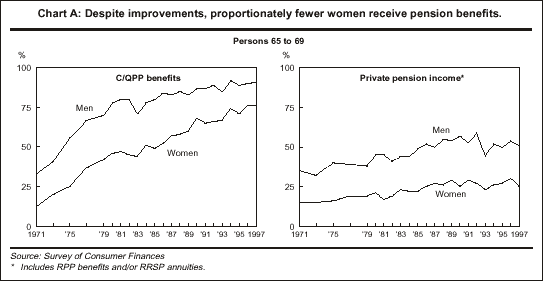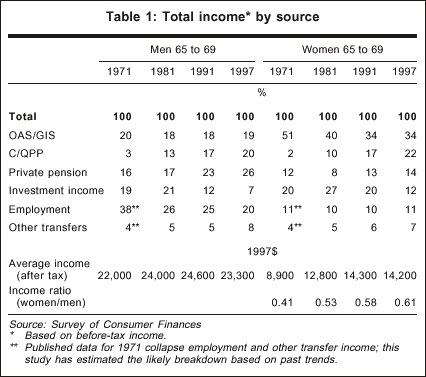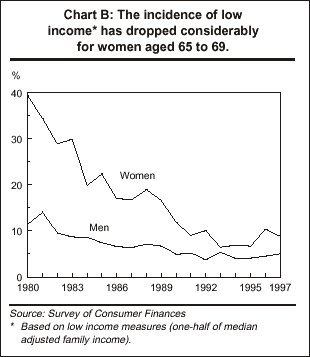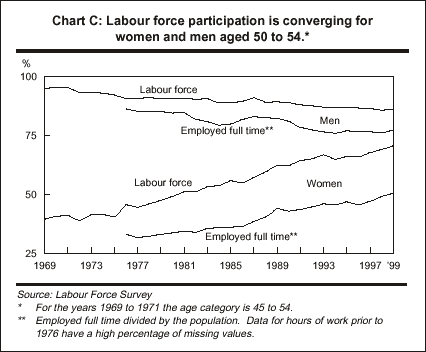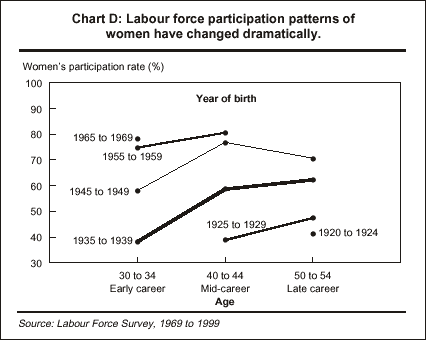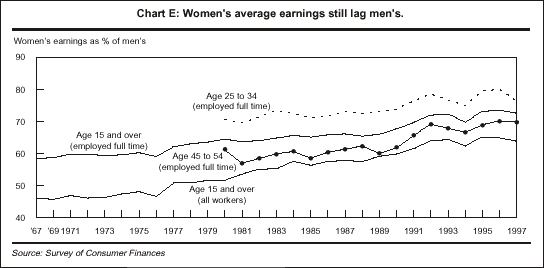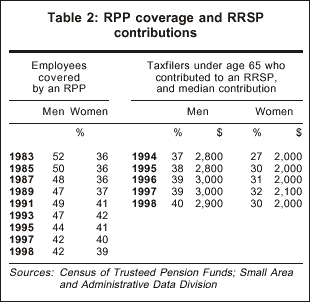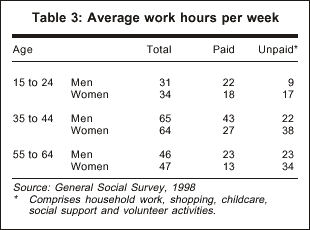
75-001-XIE

 |
December 2000 Vol. 1, no. 3 |
Incomes of younger retired women: the past 30 years
Like many OECD countries, Canada is going through a demographic transition. With rising life expectancy and lower fertility and net migration rates, the proportion of the population in older age groups continues to grow. The trend toward earlier retirement, coupled with increased life expectancy, has greatly extended the period of retirement, making the issue of pre-retirement financial planning more crucial than ever.
These trends have put increased financial pressure on public retirement-income security programs. Concern over these programs has led to a fundamental change in social policy regarding retirement, in which the role of government is being reduced and the responsibility for the provision of retirement income gradually transferred to the individual. This view of retirement encourages people to become more self-reliant through employer-sponsored pension plans, tax-sheltered investment accounts, and other investments. This raises concerns for elderly women who, compared with men, have traditionally had lower average incomes and have relied heavily on income from universal old-age transfer payments.
Furthermore, the ability to become "self-reliant" assumes strong labour force attachment and sufficient earnings prior to retirement, as most pension plan benefits are dependent on previous earnings and length of service, and contributions to tax-sheltered investment plans depend largely on how much a person can afford to set aside. Even though the labour force experiences of women and men are more similar today, considerable differences persist-differences attributable to women's primary role in caring for the household. As a consequence, it can be assumed that most women will have lower non-government retirement income than men.
This article examines the extent of change in the source, distribution and level of individual incomes of younger retired women (and men) that has resulted from the development and maturation of public and private pension plans. The younger retired (aged 65 to 69) are examined, since they represent the most recently retired and therefore the most affected by relatively recent changes to pension plan benefits and other determinants of retirement income. As the elderly of the future, their initial retirement incomes are likely to persist. ![]() 1 In other words, 65-to-69 year-olds can be viewed as the flow into the stock of retired persons. Trends in the incomes of this age group are, therefore, somewhat predictive of trends in the future incomes of the population aged 65 and over.
1 In other words, 65-to-69 year-olds can be viewed as the flow into the stock of retired persons. Trends in the incomes of this age group are, therefore, somewhat predictive of trends in the future incomes of the population aged 65 and over.
The article also examines the long-term change in women's labour force involvement (including participation, earnings and pension coverage) as one of the reasons for the reduction of differences between the incomes of elderly women and men. As well, it discusses how both future labour market changes for women and current social roles may eventually affect women's retirement income.
This study analyzes the incomes of individuals and, with the exception of the section on low incomes, makes no reference to the incomes of the people with whom they may live. For those who live in families, individual incomes are not indicative of their standard of living or economic well-being, since that is a function of family income (that is, the sum of individual incomes of those who make up the family).
Individual incomes are used here to show how past trends have influenced the relative incomes of individual men and women aged 65 to 69, and how the incomes of those in this age group will influence the relative incomes of older age groups as the former continue to age. Individual incomes of persons aged 65 to 69 tend to be stable over time. Family incomes are unstable. The death of a spouse, particularly the one with the higher income, will often have a dramatic effect on the surviving spouse's standard of living. But it will not lower that person's individual income. (In cases of retirement income sources with survivor's benefits, it may even increase it.) This means, for example, that a woman's income at age 65 to 69 is indicative of her income many years later when, given the differences in life expectancy between men and women, the probability of widowhood is much greater and a decline in standard of living may occur.
Overview of income sources
The income of elderly Canadians is derived mainly from three broad sources, often described as tiered:
First tier: OAS and GIS
Introduced in 1952, Old Age Security (OAS), in conjunction with the Guaranteed Income Supplement (GIS), is a government income security program designed to provide a basic guaranteed income to all Canadians. It is available to all citizens aged 65 and over who meet certain residency requirements, regardless of past labour force involvement. OAS provides a monthly flat-rate benefit fully indexed to the Consumer Price Index. The benefits began being taxed in 1989 (Myles, 2000); since then, persons with higher incomes have had to repay all or part of this income. ![]() 2
2
The GIS, which began in 1967, is an income-tested supplement intended for those 65 and over with low income levels, which includes many who rely almost solely on OAS. A Spouse's Allowance was introduced in 1975 as another income supplement for those with limited income. ![]() 3 Neither of these government supplements is taxable and neither requires previous contributions. Provincial governments also provide supplemental income programs for elderly persons with low income, although these are small relative to the programs just described.
3 Neither of these government supplements is taxable and neither requires previous contributions. Provincial governments also provide supplemental income programs for elderly persons with low income, although these are small relative to the programs just described.
Second tier: C/QPP  4
4
Since 1966, these government-sponsored social insurance plans have been aimed at providing workers with a certain level (roughly 25%) of previous earnings, up to a ceiling, ![]() 5 after retirement. The plans provide mandatory coverage for all workers aged 18 and over, regardless of status (for example, full-time, part-time, employees or self-employed workers), and both employees and employers are required to contribute.
5 after retirement. The plans provide mandatory coverage for all workers aged 18 and over, regardless of status (for example, full-time, part-time, employees or self-employed workers), and both employees and employers are required to contribute. ![]() 6 Benefits are available to anyone aged 60 or over who has worked and contributed to the Canada and Quebec Pension Plans (C/QPP),
6 Benefits are available to anyone aged 60 or over who has worked and contributed to the Canada and Quebec Pension Plans (C/QPP), ![]() 7 but the amount depends on the contributory period and annual average earnings during that period.
7 but the amount depends on the contributory period and annual average earnings during that period.
Third tier: Private savings
Employer-sponsored registered pension plans (RPP), also known as "private" pension plans to distinguish them from the C/QPP, have existed since the late 1800s but became widespread after the Second World War. They are provided to workers by some employers and unions and are designed to replace a proportion of previous earnings after retirement. Most RPPs require both the employee and employer to make contributions. Benefit rates are usually calculated as a fixed percentage of earnings for each year of service, and the formula is meant to replace approximately 60% to 70% of previous earnings for those with many years of service (Statistics Canada, 1996). ![]() 8
8
Registered retirement savings plans (RRSP), introduced in 1957, were designed to provide individual workers with a tax incentive to save for retirement. The annual maximum workers could save has changed several times since 1957, but throughout the years the ceiling for those with RPPs has been lower than for those without. Since 1991, the plan has allowed taxpayers to contribute up to 18% of their annual earned income, and then to defer paying tax on the amount contributed and on any interest or capital gains earned.
Income
Source of income has altered for the elderly
The enhancement and maturation of public and private pension plans in Canada have resulted in changes to the type of income young retirees have received over the past 30 years. Although the incidence rate for receiving pension benefits has increased for both sexes, the rate for women, because of their relatively low involvement in the labour force, has been consistently lower than men's. For example, in 1992, after the C/QPP had been in existence for 25 years, 89% of men aged 65 to 69 were receiving retirement benefits from the plans, compared with only 66% of women (Chart A). However, because these plans are compulsory, and women's labour force participation has been increasing, the incidence rate for C/QPP benefits reached 76% for women in 1997 (up 10 percentage points). The rate for men increased to 91% (up 2 points).
By 1997, some 50% of men and 25% of women aged 65 to 69 were receiving some income from a private pension. ![]() 9 The proportion has increased for both sexes since 1971, but in contrast to the experience with the C/QPP, the difference between the two has not yet narrowed. One of the reasons for this may be the exclusion of most part-time workers (who are predominantly women) from RPPs until the 1980s (Statistics Canada, 1996).
9 The proportion has increased for both sexes since 1971, but in contrast to the experience with the C/QPP, the difference between the two has not yet narrowed. One of the reasons for this may be the exclusion of most part-time workers (who are predominantly women) from RPPs until the 1980s (Statistics Canada, 1996).
... as has the distribution
The increasing incidence of receiving second- and third-tier type income (public and private pensions) has changed both the distribution of income sources and the total income for the recently retired (Table 1). Again, the effect of pension income has been more striking for men than for women. By 1997, private pension income had become the main source of income for men aged 65 to 69 and represented 26% of the total, up from 16% in 1971. Private pension income for women represented just 14% of the total, only slightly more than it had in 1971 (12%).
On the other hand, whereas C/QPP income was almost non-existent in 1971, it had come to represent one-fifth of income for both women and men by 1997. And, although reduced from 51% in 1971 to 34% in 1997, OAS/GIS remained women's main source of income. Equally noteworthy is men's decreased reliance on employment income, which had provided over one-third in 1971 but was down to one-fifth in 1997, reflecting declining labour force participation for this group.
The proportional increases in both private and public pension income have also helped to raise the total average income of women aged 65 to 69, from $12,800 in 1981 (in 1997 dollars) to $14,200 in 1997. The increased pension income for men has helped to offset the large decrease in employment income, though not enough to prevent a slight drop in their total average income from $24,000 in 1981 to $23,300 in 1997. Overall, women's income levels have moved toward those of men. For example, in 1971 women aged 65 to 69 received 41% of men's income; by 1981, the percentage had increased to 53% and by 1997, it reached 61%.
Living in low income
The narrowing of the income gap is reflected in the changing percentages of women and men with low incomes. Low income is based on family income rather than on individual income (studied everywhere else in this article). The incidence of low income is, therefore, a function not just of individual income, but, for persons living in families, of their combined (that is, family) income. In any case, in 1980 some 39% of women aged 65 to 69 were living in low income; that is, their after-tax family income was less than 50% of the median adjusted ![]() 10 income of all families and unattached individuals regardless of age. This rate had decreased to 9% by 1997 (Chart B). Although the incidence of low income dropped for men aged 65 to 69 as well, the change was much smaller: from 11% to 5%.
10 income of all families and unattached individuals regardless of age. This rate had decreased to 9% by 1997 (Chart B). Although the incidence of low income dropped for men aged 65 to 69 as well, the change was much smaller: from 11% to 5%.
In short, the proportion of younger retired persons receiving public and private pension benefits has increased steadily since these income programs were introduced. Furthermore, these sources have come to represent a larger proportion of total income. However, the percentage receiving these pensions and the average annual amounts received have been consistently lower for women than for men. These differences narrowed somewhat during the late 1980s and the 1990s-a direct result of women's increasing involvement in the labour market. But what was the degree of labour force attachment of the women who retired during this period, and how does it compare with that of older and younger generations?
Labour force attachment
Participation rates converge
One method of examining the previous labour force attachment of several generations of younger retired women is to look at the employment behaviour of women over the years. For example, women who were aged 65 to 69 in 1999 would have been in their pre-retirement years in 1984, when they were between 50 and 54. According to this form of analysis, 54% of women aged 65 to 69 in 1999 were in the labour force in their early fifties (Chart C). This compares with a participation rate of 89% for men aged 50 to 54 in 1984. Fifteen years earlier (1969), only 39% of women aged 50 to 54 were in the labour force; by 1999, a full 71% of this age group were participating. An opposite trend is revealed for men: whereas a full 95% aged 50 to 54 were in the labour force in 1969, only 86% of men in their early fifties were participating by 1999.
So, too, have full-time employment rates (in this study, full-time employment expressed as a proportion of the population in the same age group) dropped for men aged 50 to 54 and increased for women. That being said, men have consistently been more likely than women to work full time. As of 1999, their full-time employment rate was still considerably higher than women's: 77% versus 50%.
Women's participation now high throughout life cycle
Although a majority of women may now be participating in the labour force a decade before the traditional age of retirement, pension eligibility and earnings-replacement rates are generally dependent on lifetime years of service. A common pattern for women of earlier generations was to withdraw from the labour force through the child-rearing years, and then return to work once their children had grown up. Cohort analysis as a proxy for lifetime labour force participation rates confirms that rates have tended to rise as women age. ![]() 11 For almost all groups examined, labour force participation was lowest when the women were in their early thirties and highest when they were in their early fifties (Chart D).
11 For almost all groups examined, labour force participation was lowest when the women were in their early thirties and highest when they were in their early fifties (Chart D).
Not only is the pre-retirement participation rate higher for the cohort born soon after World War II, but so too are the early and mid-career rates of women from more recent generations. For example, only 39% of women born between 1925 and 1929 were participating in the labour force in their early forties, compared with 81% of women born between 1955 and 1959. Women today tend to have high labour force participation rates throughout their adult lives. For the women who retired in the late 1990s, labour force participation was strong only at the end of their working lives.
Earnings converge as well
Pension benefits are a function of both the number of years in which someone contributed to the plan and the earnings during the years when contributions were made. The data in the previous section suggest a steady increase in the number of years that women are potential contributors to pension plans, compared with a slight decline for men. This section looks at the earnings of women and men.
For a number of reasons not addressed here, women have consistently earned less than men. However, similar to the trend for labour force participation rates, the earnings gap between women and men narrowed over 30 years. In 1967, earnings of women working full year full time were 58% of men's, but had increased to 72% by 1997 (Chart E). Also, as seen earlier, not only do younger women now have higher-than-ever participation rates, but they have also made the largest gains in earned income relative to men's. For example, in the late 1990s women aged 25 to 34 working full year full time had earnings close to 80% of their male counterparts'. That said, full-time working women who retired in the late 1990s-the key interest group-were earning only around 60% of men's earnings during their pre-retirement years (aged 45 to 54 in the early 1980s).
Women's participation in private pensions increasing
In terms of average individual retirement incomes, the amount from pension schemes is a function of three variables: years of contribution, level of earnings while contributing, and the probability of having contributed at all. The third variable does not play a role in the case of the C/QPP, since coverage is effectively universal. However, private pensions are less inclusive, so the proportions of men and women participating in a private pension plan will have a bearing on the level (and composition) of average retirement incomes measured over the entire population.
More women now belong to an RPP, for two main reasons: their labour force participation has increased, and so too has their access to this benefit. In 1983, some 36% of women in paid jobs were members of an RPP. This rate had increased to 39% by 1998 (Table 2). The employee coverage rate for women has grown largely because of revised legislation that has required employers with RPPs to include part-time workers. In contrast, the coverage rate for men dropped from 52% in 1983 to 42% in 1998. This can be attributed primarily to the proportional employment decreases in areas such as manufacturing and the public sector, industries that are more likely than others to offer RPPs.
In the long term, retired women may be almost as likely as men to receive a pension from an RPP. However, given the differential earnings of women and men, the level of benefits will not be the same. This is because over 70% of all RPP members belong to plans that calculate pension benefits as a percentage of previous earnings. For the vast majority of these members, pensions are accrued at 2% for each year of service. That is, average annual pensions will equal 2% of earnings multiplied by the number of years of participation in the plan.
With regard to RRSPs, approximately 3 out of 10 women and 4 out of 10 men were making contributions by the end of the 1990s, with women putting away roughly two-thirds of men's savings ($2,000 versus $2,900 in 1998). As with RPP coverage, women's lower contribution rates and amounts have been influenced by lower labour force participation rates and lower average earnings. ![]() 12 However, some women may benefit from RRSP rules allowing contributions to be made on behalf of lower earning spouses and claimed as tax deductions by the earners themselves.
12 However, some women may benefit from RRSP rules allowing contributions to be made on behalf of lower earning spouses and claimed as tax deductions by the earners themselves. ![]() 13 Although RRSP participation rates can be a useful indicator of retirement planning, lifetime accumulation levels are more important, albeit not currently known.
13 Although RRSP participation rates can be a useful indicator of retirement planning, lifetime accumulation levels are more important, albeit not currently known. ![]() 14
14
Income, labour force attachment and social roles
For many of the key factors associated with pension benefits-number of years of labour force participation, level of earnings, and pension plan coverage-the experiences of women and men are becoming more similar. This confirms the sense that traditional roles of husband-as-breadwinner and wife-as-homemaker have been converging. Recent time-use data show that although work roles still tend to follow these lines, women, on average, are increasing their time spent on paid work, and men are increasing their time spent on housework, childcare and other unpaid work. However, despite a "blending" of the roles, women still carry most household and family responsibilities (Table 3), and this affects the time they have available for paid work, and ultimately, their economic success: "Even where women work outside the home, they generally carry the major responsibility for home and family. This has an impact on their career advancement and their earning capacity" (Townson, 1995). Therefore, given the continuing role distinction, it is unlikely that women's and men's labour force attachment will match in the near future. This means retirement incomes will continue to differ as well, since the ability to save depends on level of earnings. Furthermore, pension benefits are dependent on total years of service and previous earnings; even though some RPPs take into account women's role in family responsibilities, ![]() 15 most do not.
15 most do not.
Conclusion
Younger retired Canadians are becoming more reliant on pension income and personal savings. For example, income from the Canada and Quebec Pension Plans and private pensions represented only 14% of total income for women aged 65 to 69 in 1971, and 19% for men. By 1997, the income from these sources had increased to 36% and 46%, respectively. However, despite some narrowing of the difference in the late 1980s and the 1990s, the percentage of women receiving pensions and the average amounts received remain considerably lower than those of men.
The narrowing of the difference between women's and men's retirement income in the late 1990s can be attributed partly to the greater lifetime labour force attachment of recently retired women. The income difference will most likely continue to diminish in the future because of the even stronger labour force involvement of young women today. However, given that women are still predominantly responsible for most household and family work, it would be unrealistic to expect their lifetime attachment to equal that of men, at least for some time. Therefore, it is also unlikely that women's and men's retirement income will converge completely.
Notes
- The extent to which initial retirement incomes persist is largely a function of source of income. Indexed pension plans (public or private) will preserve the purchasing power of income received at age 65 to 69, as will indexed government transfer payments. The value of private pension plans with fixed benefits will be eroded by inflation. Investment income, to the extent that it comes from interest payments, will tend to vary according to the prevailing interest rate.
- More recently, the amount paid under OAS in any one year is based on the previous year's income. This has the same general effect as taxing the benefit after it is received.
- This is available to persons 60 to 64 who are married to GIS recipients (or widow[er]s of former recipients).
- The Quebec Pension Plan is administered by the province of Quebec but is viewed in this article as identical to the Canada Pension Plan, which operates in the other nine provinces and the three territories.
- The ceiling is based on an estimate of average annual earnings and is updated regularly.
- The self-employed must pay both the employee and employer share of C/QPP contributions.
- In order to be eligible for benefits, the CPP requires at least one payment, while the QPP requires contributions for a minimum of one year.
- In many cases, employer-sponsored pension plans have been "integrated" with the Canada and Quebec Pension Plans so that the earnings replacement ratio (say, 50%) is achieved through a combination of the plans' respective benefits.
- Some women may have been receiving survivor's benefits, although the incidence of this was probably low for the 65-to-69 year group.
- Income was adjusted for family size only.
- Cohort analysis of cross-sectional data enables estimations of lifelong participation rates; however, it cannot tell about the movement of women into and out of the labour force, which is an important element when determining total years of service. Longitudinal data are needed to know the number and duration of work interruptions for women over the past 30 years.
- While women as a group are less likely to contribute to an RRSP than men, this reflects the higher earnings of men. For both men and women, the higher the income the higher the RRSP participation rate. When disaggregated by income, at each income level women are more likely than men to be RRSP participants (Statistics Canada, 1999).
- The practice of making spousal contributions is not widespread. In 1989, only 3.4% of RRSP contributors made some or all of their contribution in their spouses' names; 98% of these contributors were husbands (Frenken, 1991).
- The 1999 Survey of Financial Security, to be released in December 2000, should provide important information on total RRSP savings. This survey will also provide the first review since 1984 of the amounts invested outside RRSPs and of the value of non-financial assets such as dwellings, both of which are important in the determination of economic well-being in retirement years.
- The federal public service pension plan allows employees to take up to five years off for the "care and nurturing" of preschool-aged children; employees are then able to "buy back" these pensionable years of service when they return to work. The buy-back option is also available for other kinds of extended leave.
References
- Frenken, H. "Women and RRSPs." Perspectives on Labour and Income (Statistics Canada, Catalogue no. 75-001-XPE) 3, no. 4 (Winter 1991): 8-13.
- Myles, J. The Maturation of Canada's Retirement Income System: Income Levels, Income Inequality and Low-income among the Elderly. Catalogue no. 11F0019MPE, no. 147. Ottawa: Statistics Canada, 2000.
- Oja, G. and R. Love. Pensions and Incomes of the Elderly in Canada, 1971-1985. Catalogue no. 13-588-XPB, no. 2. Ottawa: Statistics Canada, 1988.
- Statistics Canada. Pension Plans in Canada. Catalogue no. 74-401-XIB. Ottawa, 1999.
- ---. Retirement Savings Through RPPs and RRSPs, 1991 to 1997. Catalogue no. 74F0002XPB. Ottawa, 1999.
- ---. Earnings of Men and Women. Catalogue no. 13-217-XPB. Ottawa, 1997.
- ---. Canada's Retirement Income Programs: A Statistical Overview. Catalogue no. 74-507-XPB. Ottawa, 1996.
- Townson, M. Women's Financial Futures: Mid-life Prospects for a Secure Retirement. Ottawa: Canadian Advisory Council on the Status of Women, 1995.
Author
Katherine Marshall is with the Labour and Household Surveys Analysis Division. She can be reached at (613) 951-6890 or marskat@statcan.gc.ca.
|
|
|
|
|
[ Highlights ] [ Main menu | Editor's corner | More news | Contact us | Survey information | Back issues ] [ Statistics Canada home page | In depth | Français ] |
|
© Statistics Canada - Conditions of use |
